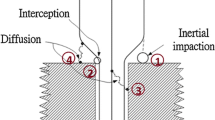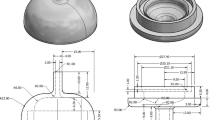Abstract
Applying engineering controls to airborne engineered nanoparticles (ENPs) is critical to prevent environmental releases and worker exposure. This study evaluated the effectiveness of two air sampling and six air cleaning fabric filters at collecting ENPs using industrially relevant flame-made engineered nanoparticles generated using a versatile engineered nanomaterial generation system (VENGES), recently designed and constructed at Harvard University. VENGES has the ability to generate metal and metal oxide exposure atmospheres while controlling important particle properties such as primary particle size, aerosol size distribution, and agglomeration state. For this study, amorphous SiO2 ENPs with a 15.4 nm primary particle size were generated and diluted with HEPA-filtered air. The aerosol was passed through the filter samples at two different filtration face velocities (2.3 and 3.5 m/min). Particle concentrations as a function of particle size were measured upstream and downstream of the filters using a specially designed filter test system to evaluate filtration efficiency. Real time instruments (FMPS and APS) were used to measure particle concentration for diameters from 5 to 20,000 nm. Membrane-coated fabric filters were found to have enhanced nanoparticle collection efficiency by 20–46 % points compared to non-coated fabric and could provide collection efficiency above 95 %.






Similar content being viewed by others
References
Balazy A, Podgorski A, Gradon L (2004) Filtration of nanosized aerosol particles in fibrous filters. I—experimental results. J Aerosol Sci 35(2):967–980
Bergmann L (1979) Needled felts for fabric filters. Environ Sci Technol 13(12):1472–1475
Brown RC (1993) Air filtration—an integrated approach to the theory and applications of fibrous filters. Pergamon Press, New York
Culhane FR (1974) Fabric filters abate air emissions. Environ Sci Technol 8(2):127–130
Danielson JA (1973) Air pollution control equipment for particulate matter, Air pollution engineering manual, AP-40. US Environmental Protection Agency, Research Triangle Park, NC, pp 91–168
Demokritou P, Büchel R, Molina RM, Deloid GM, Brain JD, Pratsinis SE (2010) Development and characterization of a versatile engineered nanomaterial generation system (VENGES) suitable for toxicological studies. Inhalation Toxicol 22:107–116
Gao P, Jaques PA, Hsiao TC, Shepherd A, Eimer BC, Yang M, Miller A, Gupta B, Shaffer R (2011) Evaluation of nano- and submicro particle penetration through ten nonwoven fabrics using a wind-driven approach. J Occup Environ Hyg 8(1):13–22
Golanski L, Guillot A, Tardif F (2008) Efficiency of fibrous filters and personal protective equipments against nanoaerosols. Nanosafe Dissemination Report, DR-325/326-200801-1, Project ID-NMP2-CT-2005-515843, Nanosafe2 project website: http://www.nanosafe.org
Golanski L, Guiot A, Rouillon F, Pocachard J, Tardif F (2009) Experimental evaluation of personal protective devices against graphite nanoaerosols: fibrous filter media, masks, protective clothing, and gloves. Hum Exp Toxicol. doi:10.1177/0960327109105157
Golanski L, Guiot A, Tardif F (2010) Experimental evaluation of individual protection devices against different types of nanoaerosols: graphite, TiO2, and Pt. J Nanopart Res. doi:10.1007/s11051-009-9804-x
Heim M, Mullins BJ, Wild M, Meyer J, Kasper G (2005) Filtration efficiency of aerosol particles below 20 nanometers. Aerosol Sci Technol 39:782–789
Hinds WC (1999) Aerosol technology—properties, behavior, and measurement of airborne particles. Wiley-Interscience, New York
Japuntich DA, Franklin LM, Pui DY, Kuehn TH, Kim SC, Viner AS (2007) A comparison of two nano-sized particle air filtration tests in the diameter range of 10 to 400 nanometers. J Nanopart Res 9:93–107
Kim SC, Harrington MS, Pui DYH (2007) Experimental study of nanoparticles penetration through commercial filter media. J Nanopart Res 9:117–125
Madler L, Kammler HK, Mueller R, Pratsinis SE (2002) Controlled synthesis of nanostructured particles by flame spray pyrolysis. J Aerosol Sci 33:369–389
Ma-Hock L, Treumann S, Strauss V, Brill S, Luizi F, Mertler M, Wiench K, Gamer AO, van Ravenzwaay B, Landsiedel R (2009) Inhalation toxicity of multiwall carbon nanotubes exposed in rats for 3 months. Toxicol Sci. doi:10.1093/toxsci/kfp146
Neundorfer Particulate Knowledge Baghouse/Fabric Filters KnowledgeBase (2011) http://www.neundorfer.com/knowledge_base/baghouse_fabric_filters.aspx. Accessed Sep 2011
Pall Corporation Glass Fiber filters, Pall product brochure (2011) http://labfilters.pall.com/catalog/laboratory_20027.asp. Accessed Sep 2011
Poland CA, Duffin R, Kinloch I, Maynard A, Wallace WAH, Seaton A, Stone V, Brown S, MacNee W, Donaldson K (2008) Carbon nanotubes introduced into the abdominal cavity of mice show asbestos-like pathogenicity in a pilot study. Nat Nanotechnol. doi:10.1038/nnano.2008.111
Pratsinis SE (1998) Flame aerosol synthesis of ceramic powders. Prog Energy Combust Sci 24:197–219
Pratsinis SE (2010) Aerosol-based technologies in nanoscale manufacturing: from functional materials to devices through core chemical engineering. AIChE J 56:3028–3035
Rengasamy S, King WP, Eimer BC, Shaffer RE (2008) Filtration performance of NIOSH-approved N95 and P100 filtering facepiece respirators against 4 to 30 nanometer-size nanoparticles. J Occup Environ Hyg 5:556–564
Rengasamy S, Eimer BC, Shaffer RE (2009) Comparison of nanoparticle filtration performance of NIOSH-approved and CE-marked particulate filtering facepiece respirators. Ann Occup Hyg 53:117–128
Rengasamy S, Eimer B, Shaffer RE (2010) Simple respiratory protection—evaluation of the filtration performance of cloth masks and common fabric materials against 20–1000 nm size particles. Ann Occup Hyg 54:789–798
Rengasamy S, Miller A, Eimer BC (2011) Evaluation of the filtration performance of NIOSH-approved N95 filtering facepiece respirators by photometric and number-based test methods. J Occup Environ Hyg 8:23–30
Ryman-Rasmussen JP, Cesta MF, Brody AR, Shipley-Phillips JK, Everitt JI, Tewksbury EW, Moss OR, Wong BA, Dodd DE, Andersen ME, Bonner JC (2009) Inhaled carbon nanotubes reach the subpleural tissue in mice. Nat Nanotechnol 4:747–751
Shaffer RE, Rengasamy S (2009) Respiratory protection against airborne nanoparticles: a review. J Nanopart Res 11:1661–1672
Shvedova AA, Kisin ER, Mercer R, Murray AR, Johnson VJ, Potapovich AI, Tyurina YY, Gorelik O, Arepalli S, Schwegler-Berry D, Hubbs AF, Antonini J, Evans DE, Ku BK, Ramsey D, Maynard A, Kagan VE, Castranova V, Baron P (2005) Unusual inflammatory and fibrogenic pulmonary responses to single-walled carbon nanotubes in mice. Am J Physiol Lung Cell Mol Physiol. doi: 10.1152/ajplung.00084.2005
Shvedova AA, Kisin ER, Murray AR, Johnson VJ, Gorelik O, Arepalli S, Hubbs AF, Mercer R, Keohavong P, Sussman N, Jin J, Yin J, Stone S, Chen BT, Deye G, Maynard A, Castranova V, Baron PA, Kagan VE (2008) Inhalation vs. aspiration of single-walled carbon nanotubes in C57BL/6 mice: inflammation, fibrosis, oxidative stress, and mutagenesis. Am J Physiol Lung Cell Mol Physiol. doi:10.1152/ajplung.90287.2008
Sotiriou GA, Diaz E, Long MS, Godleski J, Brain J, Pratsinis SE, Demokritou P (2011) A novel platform for pulmonary and cardiovascular toxicological characterization of inhaled engineered nanomaterials. Nanotoxicology. doi: 10.3109/17435390.2011.604439
Strauss W (1975) Industrial gas cleaning. Pergamon Press, New York
Takagi A, Hirose A, Nishimura T, Fukumori N, Ogata A, Ohashi N, Kitajima S, Kanno J (2008) Induction of mesothelioma in p53± mouse by intraperitoneal application of multi-wall carbon nanotube. J Toxicol Sci 33:105–116
VanOsdell DW, Liu BYH, Rubow KL, Pui DYH (1990) Experimental study of submicrometer and ultrafine particle penetration and pressure drop for high efficiency filters. Aerosol Sci Technol. doi:10.1080/02786829008959403
Whatman GE Healthcare Whatman Filter, Air Sampling Filters and Quartz Filters (2011) http://www.whatman.com/AirSamplingandQuartzFilters.aspx. Accessed Sep 2011
Acknowledgments
Authors would like to acknowledge the financial support from the Nanoscale Science and Engineering Centers for High-rate Nanomanufacturing (CHN) funded by the National Science Foundation (Award No. NSF-0425826), the NIEHS Grant (ES-0000002), the Center for Nanotechnology and Nanotoxicology at Harvard School of Public Health, the Program of Research Education for Undergraduate students associated with CHN, the Swiss National Science Foundation (Grant No. 200020-126694) and the European Research Council.
Author information
Authors and Affiliations
Corresponding author
Additional information
Special Issue Editors: Candace S.-J. Tsai, Michael J. Ellenbecker
This article is part of the Topical Collection on Nanotechnology, Occupational and Environmental Health
Appendix: environmental filtration control of engineered nanoparticles
Appendix: environmental filtration control of engineered nanoparticles
See Fig. 6
Rights and permissions
About this article
Cite this article
Tsai, C.SJ., Echevarría-Vega, M.E., Sotiriou, G.A. et al. Evaluation of environmental filtration control of engineered nanoparticles using the Harvard Versatile Engineered Nanomaterial Generation System (VENGES). J Nanopart Res 14, 812 (2012). https://doi.org/10.1007/s11051-012-0812-x
Received:
Accepted:
Published:
DOI: https://doi.org/10.1007/s11051-012-0812-x





